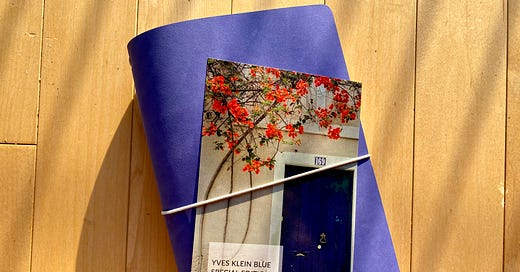Art History: Yves Klein Blue
I went notebook shopping at Jenni Bick last Friday, and I was immediately struck by a shelf of vibrant, deep blue journals. The stationary store is one of my favorite local (and woman-owned!) businesses, and their store-brand line of reusable journal covers come in rotating seasonal hues. This season’s line includes a limited edition inspired by “the most perfect expression of blue used by renowned French artist Yves Klein,” according to the card that accompanied the notebook.
Klein registered his blue under the name International Klein Blue in 1960. The color is mostly ultramarine, a hue taken from lumps of Afghani lapis lazuli that dates back to the Silk Road, according to The Secret Lives of Color by Kassia St. Clair. But, it’s the binder—the liquid added to the crushed dry pigment—that makes Klein Blue so impactful: The synthetic, matte resin suspends the pigment, maintaining its intensity without refracting or diluting as oil binders do. Klein worked with a Parisian chemist to achieve this effect. The MoMa’s page on Klein Blue explains that application with a textured roller revels the truest form of the blue.
The color shows up throughout Klein’s career, but in became central to his work in 1958 with a series of monochromatic canvases, some of which were painted by covering naked models in paint and having them roll around. Klein called them “living paintbrushes,” conceiving of the process as part of what he perceived to be art’s evolution toward the immaterial, ephemeral, and experiential.
He called a monochromatic, Klein Blue canvas an “open window to freedom.”
Isn’t that nice?
Until next week,
Elizabeth
This newsletter is just one facet of Zhuzh, my platform dedicated to conscious consumption and making space for delight. I offer secondhand-and-vintage-based wardrobe and interior styling services, art curation, and super chill life coaching. Keep up with me on Instagram and learn more at www.zhuzhlife.com.





